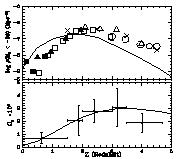


8.3. Hierarchical merging scenario
Semi-analytic models, based on the Press-Schechter formalism, and a CDM hierarchical scenario of galaxy formation (Kauffmann & Haehnelt 2000), can reproduce rather well the essential observations: the proportionality relation between the bulge and black hole mass in every galaxy, the amount of energy radiated over the Hubble time due to accretion onto massive black holes, the past evolution of AGN activity. The assumptions are that the black holes grow through galaxy merging, both because of the merger of the pre-existing black holes, and due to the infall of gas to the center in the merging, that can fuel the merged BH. It is also assumed that the cold gas in galaxies decrease with time; this implies that the fueling will also decrease with time, accounting for the observed decline of AGN activity. Finally, the gas accretion time-scale is proportional to the dynamical time-scale, which is shorter at high redshift. The quasars convert mass to energy at a fixed efficiency, and cannot radiate more than the Eddington limit.
The results of such simulations are a strong decrease of the gas fraction in galaxies, from 75% at z = 3 to 10% at z = 0, corresponding to the gas density decrease observed in the damped Lyman alpha systems (cf fig 26); this implies that the black holes in the smallest ellipticals that formed at high z are relatively more massive, since there was more gas at this epoch. Ellipticals forming today have smaller black holes. Also the brightness of AGN for a given galaxy was relatively higher in the past. The rapid decline of quasars is then due to several causes:
- a decrease in the merging rate (which is also the cause of the decrease of the star forming rate)
- the decrease of the gas amount in galaxies
- the decrease of the accretion rate (the dynamical processes are slower)

|
Figure 26. top: The evolution of the
space density of quasars
with MB < - 26 for the
|
In these kind of models, it is natural to expect a ratio of proportionality between bulge and black hole masses, since they both form from the same mechanisms, the hierarchical merging, and the corresponding dynamical gas concentration. It is interesting to note that the life-time of the quasar phase, a few 107 yr is then derived.